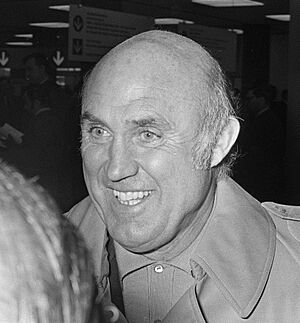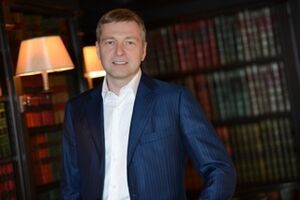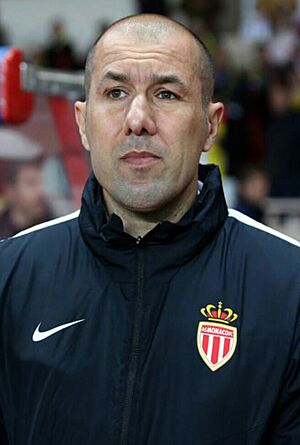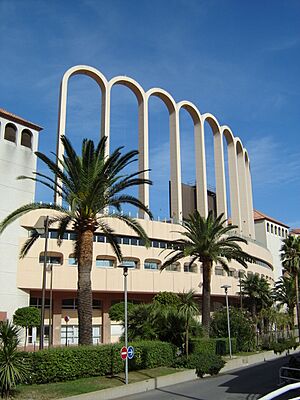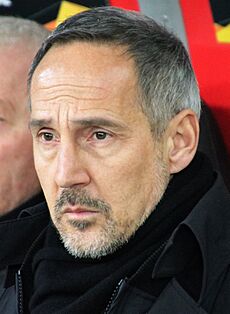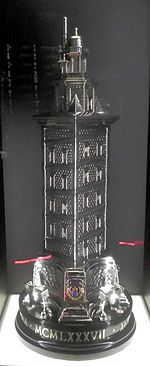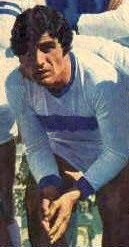AS Monaco FC facts for kids
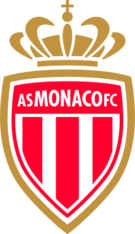 |
||
| Full name | Association Sportive de Monaco Football Club | |
|---|---|---|
| Nickname(s) | Les Rouge et Blanc (The Red and Whites) Les Monégasques (The Monégasques) Le Rocher (The Rock) |
|
| Short name | AS Monaco, ASM | |
| Founded | 23 August 1924 | |
| Stadium | Stade Louis II | |
| Stadium capacity |
16,360 | |
| Owners | Monaco Sport Investment Ltd (66.67%) House of Grimaldi (33.33%) |
|
| President | Dmitry Rybolovlev | |
| Head coach | Adi Hütter | |
| League | Ligue 1 | |
| 2021–22 | Ligue 1, 3rd of 20 | |
|
|
||
AS Monaco is a professional football club from Monaco. They are based in Fontvieille. Even though they are from Monaco, they play in France's top football league, Ligue 1. They are part of the French Football Federation. The club was started in 1918. They play their home games at the Stade Louis II. Their training center is in la Turbie, France, which is nearby.
AS Monaco is one of the most successful clubs in French football. They have won eight league titles and five Coupe de France trophies. They also won one Coupe de la Ligue. The club has played in European football many times. They were runners-up in the UEFA Cup Winners' Cup in 1992. They also reached the final of the UEFA Champions League in 2004.
The team's traditional colors are red and white. This is why they are called Les Rouge et Blanc, which means "The Red and Whites". AS Monaco is a member of the European Club Association. In 2011, a large part of the club was sold. It was bought by an investment group led by Dmitry Rybolovlev, a billionaire from Russia. With his support, the club quickly returned to Ligue 1. They won the league title in 2017, which was their first in 17 years.
Contents
Why AS Monaco Plays in France
Monaco is a small country in Europe. Unlike other small European countries, Monaco does not have its own football league. It also has never joined UEFA or FIFA as a separate football nation. Because of this, AS Monaco plays in the French league system.
AS Monaco is a full member of the French league. This means they can represent France in European competitions. There are other football clubs in Europe that play in leagues of different countries. However, AS Monaco is special because it represents a country that is not a member of international football organizations. For example, FC Vaduz from Liechtenstein plays in Switzerland. But Liechtenstein clubs have their own domestic cup to qualify for European games.
Club History: From Early Days to Today
How AS Monaco Started
AS Monaco FC was formed on August 1, 1920. It was created by combining several local clubs from France and Monaco. On August 23, 1924, a larger sports club called Association Sportive de Monaco was founded. AS Monaco FC then became the football part of this bigger club.
In its early years, Monaco played in amateur leagues. These were regional divisions in the Provence-Alpes-Côte d'Azur area of France. They quickly moved up through the leagues in the 1920s. In 1929, they moved to a new stadium called Stade des Moneghetti. This stadium was in Beausoleil, Alpes-Maritimes, France, right next to the border with Monaco. It was their first official home stadium until 1939.
In 1933, the French Football Federation invited Monaco to become a professional club. Their first year in the second division in 1933–34 was tough. They were sent back to the amateur leagues the next year. In 1939, the club moved to the Stade Louis II.
By 1948, Monaco became a professional club again. They returned to the French second division. They consistently finished near the top of the league. This led to them being promoted to the first division for the first time in 1953.
Winning Trophies: 1960 to 1986
In 1960, Monaco's coach, Lucien Leduc, led the club to its first professional trophy. They won the Coupe de France by beating AS Saint-Étienne 4–2 in extra time. The next year, they did even better. They won the French Championship for the first time. This allowed them to play in the European Cup.
Leduc then guided the club to win both the League and the Cup in 1963. After Leduc left in 1963, Monaco had a quiet period. They stayed in the middle of the league for about ten years. They also moved between the first and second divisions after 1963.
In 1975, Jean-Louis Campora became the club's chairman. He was the son of a former president. In his second season, he brought Leduc back. Leduc immediately helped the club get promoted to the first division. They then won the championship the next year in 1978. Leduc left the club again in 1979. Other coaches tried to help, but the club's performance declined.
The early 1980s saw more success in national competitions. Monaco won a title almost every other year. They won the Coupe de France in 1980 and 1985. They won the French Championship in 1982. They were also finalists in the Coupe de France in 1984. In the 1985–86 season, Monaco had a huge win. They beat Bordeaux 9–0, which was one of their biggest wins ever.
However, Monaco could not achieve similar success in Europe. Up to this point, they had never gone past the first round of any European competition.
The Wenger and Tigana Years: 1990s
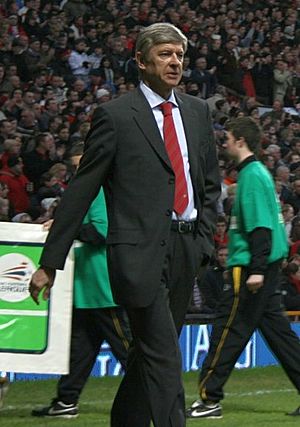
In 1986, Ștefan Kovács, a famous coach, managed Monaco. But even he could not bring them success. The club then hired Arsène Wenger, who was not very well known at the time. Wenger's time at Monaco was very successful. He signed great players like George Weah, Glenn Hoddle, Jürgen Klinsmann, and Youri Djorkaeff. The youth team also produced future World Cup winners like Emmanuel Petit, Lilian Thuram, and Thierry Henry.
Under Wenger, Monaco won the league in his first season in 1988. They also won the Coupe de France in 1991. The club often reached the later stages of the European Cup. They also regularly challenged for the league title. Wenger left the club in 1994.
After Wenger, the club won two more league championships. They won under Jean Tigana in 1997 and under Claude Puel in 2000. However, as the 1990s ended, there were rumors that the club was having financial problems. In 2003, these problems became very serious. Even though they finished second in the league, the French Professional League sent them down to Ligue 2. This was because they had a large debt. This forced President Jean-Louis Campora to step down after 28 years.
The next season, the team did very well on the field despite their money troubles. The team was coached by Didier Deschamps. They had strong players like Fernando Morientes, Ludovic Giuly, and Jérôme Rothen. They finished third in Ligue 1. They also had an amazing run to the final of the UEFA Champions League. They beat strong teams like Real Madrid and Chelsea along the way. But even with this success, the 2003–04 season was the club's worst financially.
Relegation and New Ownership
After Deschamps left, Francesco Guidolin became coach. The club tried to keep its best players, but many left. Their replacements could not achieve the same success. Guidolin lasted only one year. After several more coaching changes and mid-table finishes, the club's president, Michel Pastor, left in 2008.
In 2008, Jérôme de Bontin took over. He brought in new players, but the team did not do well. De Bontin resigned in 2009. Guy Lacombe became coach in 2009. He led Monaco to eighth place in Ligue 1 in his first season. But in his second season, the team struggled. He was fired in January 2011. Monaco finished the 2010–11 season in 18th place. This meant they were relegated to Ligue 2.
In December 2011, a large part of the club (66.67%) was sold. It was bought by Dmitry Rybolovlev, a Russian billionaire. At this time, the club was at the bottom of Ligue 2. The coach was fired, and Marco Simone took over. He improved the team's position. But the club wanted promotion, so they hired Claudio Ranieri. Ranieri's attacking style helped the team score many goals. Monaco lost only four times in the 2012–13 season. They finished as champions and were promoted back to Ligue 1.
Using Rybolovlev's money, Monaco spent a lot on new players in 2013. They spent about £140 million. This included a club record £50 million for Radamel Falcao and £40 million for James Rodríguez. Monaco finished in 2nd place in Ligue 1 in the 2013–14 season. Ranieri was replaced by Leonardo Jardim. The next season, Monaco sold some expensive players like James Rodriguez and loaned out Falcao. Despite this, Monaco finished 3rd in Ligue 1. They also reached the quarter-finals of the Champions League. They beat Arsenal before losing to Juventus.
Ligue 1 Champions and Recent Years (2016–Present)
Monaco won the Ligue 1 title on May 17, 2017. They beat AS Saint-Étienne 2–0. Radamel Falcao scored 30 goals and Kylian Mbappé scored 26 goals. This helped them win their first Ligue 1 title in 17 years. Monaco did not lose any of their last 20 games that season, winning 18 of them.
In the 2016–17 UEFA Champions League, Monaco made a great comeback. They lost the first game to Manchester City 5–3. But they won the second game 3–1 at home, winning on away goals. Monaco then beat Borussia Dortmund before losing to Juventus.
In the summer of 2017, Kylian Mbappé went to rivals PSG. He was loaned with an agreement to buy him for €180 million. This was the second-highest transfer fee in history at the time. Teammates Bernardo Silva and Benjamin Mendy were sold to Manchester City. Tiémoué Bakayoko was sold to Chelsea. Monaco still managed to finish 2nd in the 2017–18 Ligue 1, behind PSG. In 2018, Fabinho was sold to Liverpool.
Thierry Henry became coach in October 2018 after a bad start to the season. Henry was suspended in January, and Jardim returned days later. Monaco finished 17th that season, just avoiding relegation. In December 2019, Jardim was fired again. Former Spain manager Robert Moreno was appointed.
In 2019–20, the COVID-19 pandemic stopped the football season early. Monaco finished 9th. Moreno was sacked in July. He was replaced by former Bayern Munich manager Niko Kovač. Kovač led the team to third place the next season. Kovač left in early 2022. Philippe Clement took over. During Clement's time, the club did not reach the Champions League group stages. They played in the Europa League instead. In his last season, they finished 6th and did not qualify for European football.
On July 4, 2023, Monaco hired Adi Hütter as coach. He signed a two-year deal. In his first season, he guided the club to a second-place finish in the 2023–24 season. This meant they qualified for the Champions League group stage for the first time since 2018–19.
Home Stadium: Stade Louis II
Monaco has played at the Stade Louis II since 1939. In 1985, a new stadium was built nearby. This new stadium is also called the Stade Louis II. It was built on land that was created from the Mediterranean Sea. The stadium is named after Prince Louis II. It can hold 16,360 fans. The Stade Louis II is famous for its nine arches. It has hosted many sports events and European Cup finals. From 1998 to 2012, it hosted the annual UEFA Super Cup every August.
Youth Academy
Current Players
Main Squad
|
|
Players on Loan
|
|
Monaco B and Youth Teams
|
|
Club Leaders
Board of Directors
|
Current Coaching Staff
|
Club Presidents Through the Years
Coaching History
| Period | Name |
|---|---|
| 1948–1950 | |
| 1950–1952 | |
| 1952–1953 | |
| 1953–1956 | |
| 1956–1957 | |
| 1958 | |
| 1958–1963 | |
| 1963–1965 | |
| 1965–1966 | |
| 1966–1969 | |
| 1969–1970 | |
| 1970–1972 | |
| 1972–1974 | |
| 1974–1975 | |
| 1976–1977 | |
| 1977–1979 | |
| 1979–1983 | |
| 1983–1986 | |
| 1986–1987 | |
| 1987–1994 | |
| 1994 | |
| 1994–1995 | |
| 1995 | |
| 1995–1999 | |
| 1999–2001 | |
| 2001–2005 | |
| 2005 | |
| 2005–2006 | |
| 2006 | |
| 2006–2007 | |
| 2007–2009 | |
| 2009–2011 | |
| 2011 | |
| 2011–2012 | |
| 2012–2014 | |
| 2014–2018 | |
| 2018–2019 | |
| 2019 | |
| 2019–2020 | |
| 2020–2022 | |
| 2022 | |
| 2022–2023 | |
| 2023– |
Club Achievements
Domestic Trophies
- Ligue 1
- Winners (8): 1960–61, 1962–63, 1977–78, 1981–82, 1987–88, 1996–97, 1999–2000, 2016–17
- Runners-up (8): 1963–64, 1983–84, 1990–91, 1991–92, 2002–03, 2013–14, 2017–18, 2023–24
- Ligue 2
- Winners: 2012–13
- Runners-up (3): 1952–53, 1970–71, 1976–77
- Championnat de France Amateur
- Winners (3): 1963–64, 1970–71, 2007–08
- Coupe de France
- Winners (5): 1959–60, 1962–63, 1979–80, 1984–85, 1990–91
- Runners-up (5): 1973–74, 1983–84, 1988–89, 2009–10, 2020–21
- Coupe de la Ligue
- Winners: 2002–03
- Runners-up (3): 2000–01, 2016–17, 2017–18
- Trophée des Champions
- Winners (4): 1961, 1985, 1997, 2000
- Runners-up (4): 1960, 2017, 2018, 2024
- Coupe Charles Drago
- Winners: 1961
European Competitions
- European Cup Winners' Cup
- Runners-up (1): 1991–92
- UEFA Champions League
- Runners-up (1): 2003–04
Pre-Season Tournaments
- Joan Gamper Cup
- Winners (1): 2024
- Mohammed V Cup
- Winners (1): 1988
UEFA Club Ranking
| Rank | Team | Points |
|---|---|---|
| 63 | 25.500 | |
| 64 | 25.000 | |
| 65 | 24.000 | |
| 66 | 23.500 | |
| 67 | 23.000 |
Player Records
Bold means players who are still at the club.
Most Appearances
These are for competitive, professional matches only.
| # | Name | Years | Matches |
|---|---|---|---|
| 1 | 1975–1994 | 755 | |
| 2 | 1979–1996 | 602 | |
| 3 | 1969–1982 | 428 | |
| 4 | 1980–1989 | 349 | |
| 5 | 1971–1980 | 334 | |
| 6 | 1985–1993 | 326 | |
| 7 | 1953–1962 | 319 | |
| 8 | 1986–1995 | 315 | |
| 9 | 1957–1966 | 304 | |
| 10 | 1961–1972 | 303 |
Top Goalscorers
These are for competitive, professional matches only.
| # | Name | Years | Goals |
|---|---|---|---|
| 1 | 1973–1980 | 223 | |
| 2 | 2019–2024 | 118 | |
| 3 | 1959–1965 | 115 | |
| 4 | 1971–1980 | 89 | |
| 5 | 2013–2019 | 83 | |
| 6 | 1969–1982 | 78 | |
| 7 | 1993–1999 | 77 | |
| 8 | 1961–1967 | 74 | |
| 9 | 1990–1995 | 68 | |
| 10 | 1994–1997 | 67 | |
| 2000–2005 |
See also
 In Spanish: Association Sportive Monaco Football Club para niños
In Spanish: Association Sportive Monaco Football Club para niños


